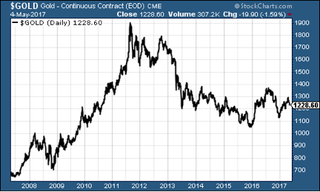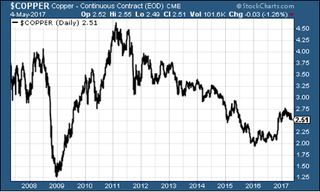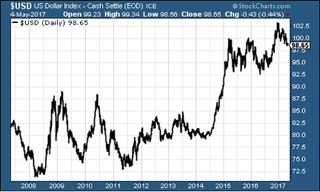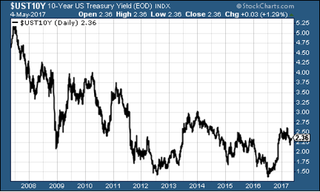A bad week for gold – but a belter for bitcoin
There have been some interesting moves in our six “charts that matter” this week, says John Stepek.


There have been some interesting moves in our six "charts that matter" this week.
Gold

Practically everything has been stacked against gold this week. Firstly, the US Federal Reserve was a tad more bullish in its assessment of the US economy than anyone had expected at its meeting on Wednesday, which caused markets to revise up their expectations for the pace of rate rises, which is never great for gold.
Secondly, markets are fairly relaxed about the French election this weekend. It might still go Marine Le Pen's way, but that does seem unlikely. Again, a calming of geopolitical nerves has made investors less inclined to own gold.
Subscribe to MoneyWeek
Subscribe to MoneyWeek today and get your first six magazine issues absolutely FREE

Sign up to Money Morning
Don't miss the latest investment and personal finances news, market analysis, plus money-saving tips with our free twice-daily newsletter
Don't miss the latest investment and personal finances news, market analysis, plus money-saving tips with our free twice-daily newsletter
Finally, the commodities sector in general has been having a tough time, as we'll get to in just a moment. This isn't always bad news for gold but on this occasion, gold has followed the rest of its industrial compatriots lower.
Copper

The big concern for commodities (and gold to a lesser extent) is China. As I wrote in Money Morning earlier this week, investors are starting to fret about a crackdown on borrowing in China and a resulting slowdown in growth.
When China reins in monetary creation, it's always bad news for the commodities sector. Whether or not this spreads to other parts of the asset markets is another question. With oil falling hard as well, markets might be inclined to look on the bright side and see it as good for consumers and for corporate profits (as costs are lower).
US dollar
US dollar

This is another chart that points to the real concern being China right now. Normally when I see gold slide, I usually look to the dollar to rise strongly and clearly that's not been the case this week.
Depending on the French election result, the dollar index could fall further the euro makes up a large chunk of the index, so if it strengthens after an Emmanuel Macron victory, then the dollar could weaken.
US Treasuries

In a similar vein, there's ten-year US Treasury bonds. Yields are continuing to pick up a little, rising from 2.3% last time, to 2.36% now. This is partly down to expectations for a Fed rate rise being brought forward by investors,
Bitcoin
I told you last week that Charlie Morris, my colleague and editor of The Fleet Street Letter, had put a $1,700 target on bitcoin. Well, we're already nearly there, as you can see:

Source:bitcoincharts.com
This is quite unusual. Bitcoin often moves similarly to gold. It also reacts badly when China seems to be in trouble (although of course, some of this week's gains could be driven by people trying to get their money out of China). So why hasn't bitcoin fallen out of bed this week with everything else?
It's partly because of huge demand from Japan. The Japanese recently deemed bitcoin a legal means of payment and investors and speculators are lapping it up.
And when you look at that chart above, you have to think that bitcoin is moving into its parabolic phase now (or another one at least). Is it a bubble? That word is overused, and in any case, I don't think it is. But as bitcoin hogs more and more headlines, and draws more and more new money, we could see a mania developing that takes the price well beyond where it is today.
Again, it's all speculative. But it's interesting stuff.
US jobless claims

As the short-term chart aboveshows, it looked as though jobless claims troughed at just under 240,000 at the end of February. So we'd be looking at the market (the S&P 500) peaking around the end of May.
However, this week jobless claims fell sharply to 238,000. Another few runs like this, and we might find that the indicator hits a new trough and maybe we're safe from recession for another few months.
John is the executive editor of MoneyWeek and writes our daily investment email, Money Morning. John graduated from Strathclyde University with a degree in psychology in 1996 and has always been fascinated by the gap between the way the market works in theory and the way it works in practice, and by how our deep-rooted instincts work against our best interests as investors.
He started out in journalism by writing articles about the specific business challenges facing family firms. In 2003, he took a job on the finance desk of Teletext, where he spent two years covering the markets and breaking financial news. John joined MoneyWeek in 2005.
His work has been published in Families in Business, Shares magazine, Spear's Magazine, The Sunday Times, and The Spectator among others. He has also appeared as an expert commentator on BBC Radio 4's Today programme, BBC Radio Scotland, Newsnight, Daily Politics and Bloomberg. His first book, on contrarian investing, The Sceptical Investor, was released in March 2019. You can follow John on Twitter at @john_stepek.
-
 Private school fees soar and VAT threat looms – what does it mean for you?
Private school fees soar and VAT threat looms – what does it mean for you?Rising private school fees could see more than one in five parents pull their children out of their current school. Before you remortgage, move house or look to grandparents for help, here’s what you need to know.
By Katie Williams Published
-
 Best and worst UK banks for online banking revealed
Best and worst UK banks for online banking revealedWhen it comes to keeping your money safe, not all banks are equal. We reveal the best and worst banks for online banking when it comes to protecting your money from scams
By Oojal Dhanjal Published